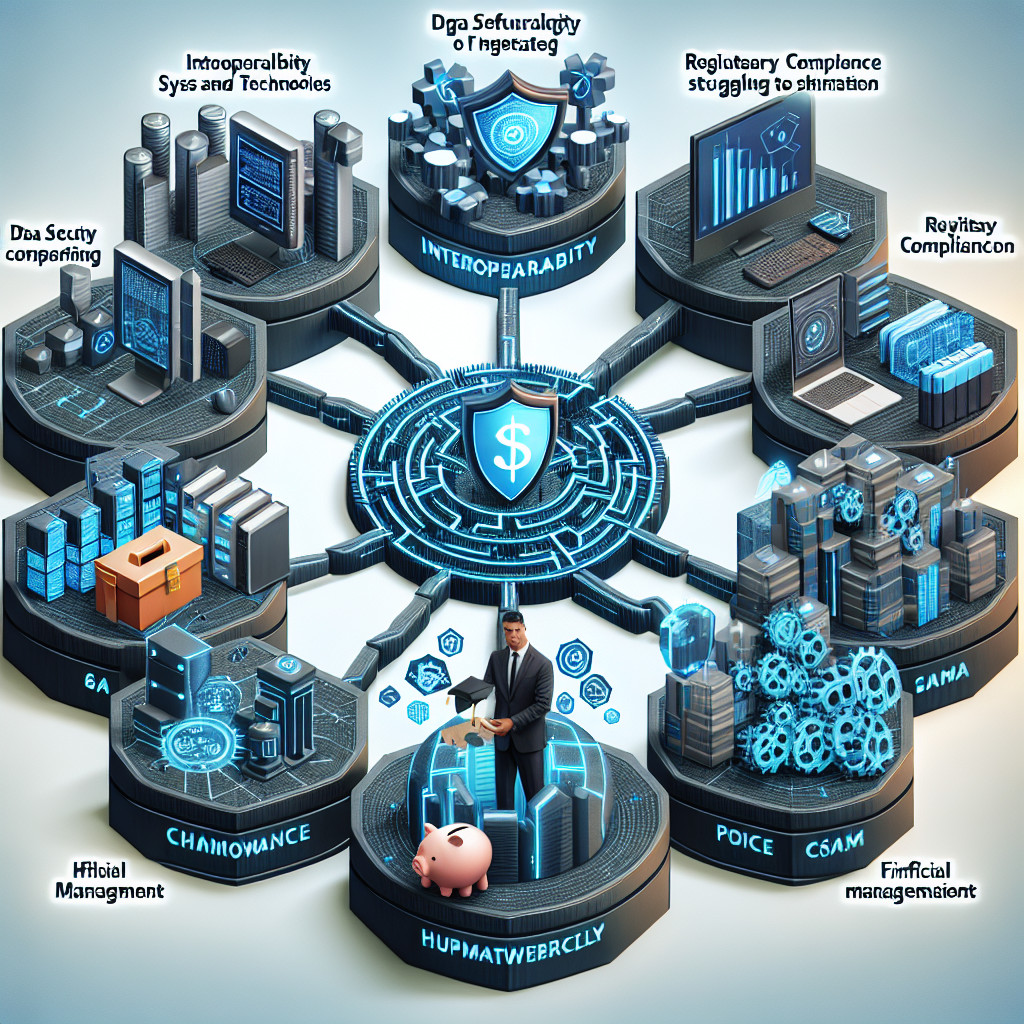
- Lack of standardized protocols for digitization in medical and pharmaceutical industries
- Ensuring interoperability of digital systems across different healthcare providers
- Overcoming technical barriers in implementing digital solutions in medical and pharmaceutical settings
- Balancing the benefits of digitization with potential risks and challenges
- Leveraging blockchain technology in securing medical and pharmaceutical data
- Overcoming challenges in implementing digital health monitoring and surveillance systems
- Overcoming challenges in implementing digital health communication and collaboration tools
- Ensuring the interoperability of digital health solutions with existing medical devices and equipment
Lack of standardized protocols for digitization in medical and pharmaceutical industries
Digitization in the medical and pharmaceutical industries involves the conversion of physical records and processes into digital formats. This can include electronic health records, digital imaging, telemedicine, and more. While digitization offers numerous benefits, such as improved data accuracy, accessibility, and efficiency, the lack of standardized protocols can pose significant risks.
Without standardized protocols, there is a lack of consistency in how data is captured, stored, and shared. This can lead to errors, inconsistencies, and security vulnerabilities. In the medical industry, this can have serious consequences for patient safety and care. In the pharmaceutical industry, it can impact drug development, regulatory compliance, and supply chain management.
Standardized protocols for digitization are essential to ensure data integrity, interoperability, and security. These protocols should outline best practices for data capture, storage, transmission, and access. They should also address issues such as data privacy, encryption, authentication, and audit trails.
Unfortunately, the lack of standardized protocols in the medical and pharmaceutical industries is a widespread problem. Different organizations and systems may have their own proprietary protocols, leading to fragmentation and inefficiencies. This can hinder collaboration, data sharing, and innovation.
To address this issue, industry stakeholders, regulators, and standards organizations need to work together to develop and implement standardized protocols for digitization. This will require collaboration, communication, and consensus-building among stakeholders with diverse interests and priorities.
By establishing standardized protocols for digitization, the medical and pharmaceutical industries can unlock the full potential of digital technologies to improve patient care, streamline processes, and drive innovation. It is essential for the future success and sustainability of these industries.
- Improved data accuracy
- Enhanced patient care
- Streamlined processes
- Standardized protocols
- Data integrity
- Interoperability
- Data security
- Collaboration
- Innovation
- Digitization in medical and pharmaceutical industries
- Standardized protocols for data capture
- Data integrity and security
- Collaboration among stakeholders
- Future of digital technologies in healthcare
#digitization #medicalindustry #pharmaceuticalindustry #standardizedprotocols #dataintegrity #security #collaboration #innovation
Ensuring interoperability of digital systems across different healthcare providers
1. Improved patient care: Interoperable systems allow healthcare providers to access and share patient information quickly and easily, leading to better coordination of care and improved patient outcomes.
2. Reduced costs: Interoperable systems can help reduce duplication of tests and procedures, leading to cost savings for both providers and patients.
3. Enhanced efficiency: Interoperable systems streamline administrative processes, such as billing and scheduling, making healthcare delivery more efficient.
4. Increased patient satisfaction: Patients benefit from interoperable systems by having their information readily available to all providers involved in their care, leading to a more seamless and coordinated experience.
To ensure interoperability of digital systems across different healthcare providers, several key strategies can be implemented:
1. Standardization of data formats: Healthcare providers should adopt common data formats and standards to ensure that information can be easily exchanged between different systems.
2. Use of health information exchanges (HIEs): HIEs are organizations that facilitate the exchange of health information between different providers, enabling seamless communication and collaboration.
3. Implementation of interoperability frameworks: Healthcare providers can use interoperability frameworks, such as HL7 and FHIR, to ensure that their systems can communicate with each other effectively.
4. Collaboration between stakeholders: Healthcare providers, software vendors, and policymakers should work together to develop and implement interoperability solutions that meet the needs of all stakeholders.
By implementing these strategies, healthcare providers can ensure that their digital systems are interoperable across different providers, leading to improved patient care, reduced costs, enhanced efficiency, and increased patient satisfaction.
#interoperability #digitalhealth #healthIT #healthcaretechnology
Keywords: interoperability, digital systems, healthcare providers, patient care, efficiency, standardization, health information exchanges, interoperability frameworks, collaboration
Long-tail phrases: Ensuring seamless communication between healthcare providers, Benefits of interoperable digital systems, Strategies for achieving interoperability in healthcare.
Overcoming technical barriers in implementing digital solutions in medical and pharmaceutical settings
Another technical barrier is data security and privacy. Medical and pharmaceutical data is highly sensitive and must be protected from unauthorized access. Implementing strong encryption, access controls, and monitoring systems can help ensure the security and privacy of patient information. Compliance with regulations such as HIPAA and GDPR is also essential to avoid legal and financial penalties.
Furthermore, technical barriers such as limited connectivity and bandwidth can hinder the implementation of digital solutions in remote or underserved areas. In these cases, leveraging technologies such as satellite internet, mobile networks, and low-power devices can help overcome these challenges and extend the reach of healthcare services.
In addition, the complexity and diversity of medical and pharmaceutical workflows can pose technical challenges in implementing digital solutions. Customizing solutions to meet the specific needs of healthcare providers, integrating with existing systems, and providing training and support are essential to ensure successful adoption and usage.
Overall, overcoming technical barriers in implementing digital solutions in medical and pharmaceutical settings requires a combination of technical expertise, strategic planning, and collaboration among stakeholders. By addressing interoperability, data security, connectivity, and workflow challenges, healthcare organizations can unlock the full potential of technology to improve patient care and outcomes.
#digitalhealth #healthtech #medicalinformatics #pharmaceuticaltechnology
Keywords: digital solutions, medical settings, pharmaceutical settings, technical barriers, interoperability, data security, privacy, connectivity, workflow challenges
Long-tail phrases: implementing digital solutions in medical settings, overcoming technical barriers in pharmaceutical settings, improving patient outcomes with technology, challenges of data security in healthcare, leveraging technology in remote healthcare delivery.
Balancing the benefits of digitization with potential risks and challenges
Benefits of digitization:
– Improved efficiency and productivity
– Enhanced customer experience
– Increased reach and accessibility
– Cost savings
– Data analytics and insights
– Automation of repetitive tasks
– Scalability and growth opportunities
Potential risks and challenges:
– Cybersecurity threats
– Data privacy concerns
– Digital divide
– Technological obsolescence
– Resistance to change
– Lack of digital skills
– Regulatory compliance
Striking a balance:
To successfully leverage the benefits of digitization while mitigating potential risks and challenges, organizations must adopt a strategic approach. This includes investing in cybersecurity measures, ensuring compliance with data protection regulations, providing training and upskilling opportunities for employees, and regularly evaluating and updating digital strategies.
Conclusion:
Digitization offers immense opportunities for businesses and organizations to innovate and grow. However, it is essential to carefully balance the benefits with potential risks and challenges to ensure long-term success and sustainability.
#digitization #technology #cybersecurity #data privacy #digital skills #regulatory compliance
Striking a balance between the benefits of digitization and potential risks and challenges is crucial for the success of businesses and organizations in the digital age.
Leveraging blockchain technology in securing medical and pharmaceutical data
1. **Immutable and transparent record-keeping**: Blockchain technology allows for the creation of a tamper-proof and transparent ledger of transactions. This can be particularly useful in maintaining accurate and secure records of patient information, drug supply chain data, and clinical trial results.
2. **Enhanced data privacy**: By using encryption and decentralized storage, blockchain technology can help protect sensitive medical and pharmaceutical data from unauthorized access. Patients can have greater control over who can access their health information, ensuring their privacy is maintained.
3. **Streamlined data sharing**: Blockchain technology enables secure and efficient sharing of data between healthcare providers, pharmacies, and other stakeholders. This can lead to improved coordination of care, faster access to medical records, and better communication among healthcare professionals.
4. **Improved drug traceability**: With blockchain, each step in the pharmaceutical supply chain can be recorded and verified, ensuring the authenticity and quality of drugs. This can help prevent counterfeit drugs from entering the market and improve patient safety.
5. **Smart contracts for automated processes**: Smart contracts, which are self-executing contracts with the terms of the agreement directly written into code, can automate various processes in healthcare and pharmaceuticals. This can reduce the risk of errors and fraud, while also increasing efficiency.
Overall, can lead to improved data security, enhanced privacy, and greater efficiency in healthcare operations. As the technology continues to evolve, it is important for stakeholders in the healthcare and pharmaceutical industries to explore the potential benefits of blockchain and implement it in their operations.
Hashtags: #blockchain #healthcare #pharmaceuticals #datasecurity #privacy
Keywords: blockchain technology, medical data, pharmaceutical data, data security, privacy
Long-tail phrases: leveraging blockchain technology for secure medical data storage, blockchain applications in pharmaceutical data security, benefits of blockchain in healthcare operations.
Overcoming challenges in implementing digital health monitoring and surveillance systems
2. Data security and privacy concerns: Another major challenge is ensuring the security and privacy of patient data. With the increasing threat of cyber attacks and data breaches, healthcare organizations need to implement robust security measures to protect sensitive information. This can include encryption, access controls, and regular security audits.
3. Resistance to change: Implementing new digital health monitoring and surveillance systems can be met with resistance from healthcare providers and staff who are used to traditional methods. To overcome this challenge, organizations should provide training and support to help staff adapt to the new systems. Additionally, involving staff in the decision-making process can help increase buy-in and acceptance.
4. Cost and resource constraints: Implementing digital health monitoring and surveillance systems can be costly and resource-intensive. To overcome this challenge, organizations should carefully assess their budget and resources before investing in new systems. They can also consider partnering with other organizations or leveraging government funding to offset costs.
5. Regulatory compliance: Healthcare organizations need to comply with various regulations and standards when implementing digital health monitoring and surveillance systems. This can include HIPAA regulations, GDPR requirements, and industry-specific standards. To overcome this challenge, organizations should stay up-to-date on regulatory changes and work with legal experts to ensure compliance.
In conclusion, implementing digital health monitoring and surveillance systems can be a complex process, but with the right strategies and tools, these challenges can be overcome. By addressing interoperability issues, ensuring data security and privacy, overcoming resistance to change, managing costs and resources, and complying with regulations, healthcare organizations can successfully implement digital health monitoring and surveillance systems to improve patient care and outcomes.
#digitalhealth #monitoring #surveillance #healthcare #challenges #interoperability #datasecurity #privacy #resistancetochange #costconstraints #regulatorycompliance
frazy kluczowe:
– Implementing digital health monitoring and surveillance systems
– Overcoming challenges in healthcare technology
– Strategies for successful digital health implementation
– Data security and privacy in healthcare monitoring systems
– Interoperability solutions for digital health systems
Overcoming challenges in implementing digital health communication and collaboration tools
Challenges in implementing digital health communication and collaboration tools:
- Lack of technical expertise among healthcare professionals
- Resistance to change from staff members
- Concerns about data security and privacy
- Integration with existing systems and workflows
- Cost of implementation and maintenance
Strategies for overcoming these challenges:
- Provide training and support for healthcare professionals
- Communicate the benefits of the tools to staff members
- Implement robust security measures to protect patient data
- Work closely with IT teams to ensure seamless integration
- Develop a budget plan and explore funding options
By addressing these challenges head-on and implementing the right strategies, healthcare organizations can successfully adopt digital health communication and collaboration tools to improve patient care and streamline workflows.
Conclusion:
While implementing digital health communication and collaboration tools may present challenges, with the right approach and dedication, these obstacles can be overcome. By investing in training, communication, security measures, and integration, healthcare organizations can harness the power of technology to enhance patient care and drive efficiency.
#digitalhealth #communication #collaboration #healthcare #technology
“Implementing digital health communication and collaboration tools in healthcare settings”
“Challenges in adopting digital health technologies”
“Strategies for successful implementation of digital health tools”
Ensuring the interoperability of digital health solutions with existing medical devices and equipment
To address this challenge, healthcare providers and technology vendors must work together to develop and implement interoperability standards. These standards define how different devices and systems should communicate with each other, ensuring seamless integration and data exchange. By adhering to these standards, healthcare organizations can ensure that their digital health solutions are compatible with existing medical devices and equipment.
In addition to interoperability standards, healthcare providers must also consider the compatibility of digital health solutions with existing infrastructure and workflows. This includes ensuring that new technologies can be easily integrated into existing systems, processes, and workflows without disrupting patient care or causing unnecessary delays.
Furthermore, healthcare providers must also consider the security and privacy implications of integrating digital health solutions with existing medical devices and equipment. With the increasing threat of cyber attacks and data breaches, it is essential to implement robust security measures to protect patient data and ensure the confidentiality of medical information.
Overall, requires collaboration, standardization, and careful planning. By addressing these challenges proactively, healthcare providers can leverage the full potential of digital technologies to improve patient care and enhance the overall healthcare experience.
#digitalhealth #interoperability #medicaldevices #healthcaretechnology #dataexchange
frazy kluczowe:
– interoperability standards in healthcare
– integrating digital health solutions with medical devices
– data exchange protocols for healthcare technology
– ensuring compatibility of digital solutions with existing infrastructure
– cybersecurity measures for healthcare data protection











